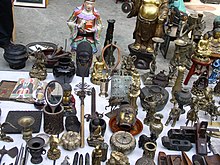Insa-dong: Difference between revisions
Caspian blue (talk | contribs) |
Undid revision 300126897 by Caspian blue (talk) removed promotional liks previously spammed across multiple articles |
||
| Line 45: | Line 45: | ||
==External links== |
==External links== |
||
{{Commons}} |
{{Commons}} |
||
* [http://english.visitkorea.or.kr/enu/SH/SH_EN_7_4.jsp?gotoPage=1&cid=561239 Official site of Korea tourism - Insa-dong, Samcheong-dong] |
|||
* [http://english.visitseoul.net/visit2007en/activities/shopping/shopping.jsp?cid=111&sid=804 Insadong, the Largest Traditional Art Market :Visitseoul] |
|||
* [http://www.lifeinkorea.com/Travel2/9 Insadong shopping area] |
* [http://www.lifeinkorea.com/Travel2/9 Insadong shopping area] |
||
Revision as of 22:17, 3 July 2009
| Insa-dong | |
 | |
| Korean name | |
|---|---|
| Hangul | 인사동 |
| Hanja | |
| Revised Romanization | Insadong |
| McCune–Reischauer | Insadong |
Insadong is a dong, or neighborhood of the Jongno-gu district of the South Korean city of Seoul. The main street is Insadong-gil, which is connected to a multitude of alleys that lead deeper into the district.
Art market
This article possibly contains original research. (May 2009) |
Insadong has been at the heart of the nation’s capital for 600 years and it has been the center of culture since the time of the Joseon Dynasty (1392-1910). This is also where the Ministry of Art was once situated. Insadong usually refers to the area from Anguk-dong Rotary to Tapgol Park in Jongno 2(i)-ga, past the Insadong Intersection. The notable features of Insadong are the countless alleys that branch out from the main street. Insadong was once known as ‘Mary’s Alley,’ and is a favorite shopping spot among foreigners.
Over forty percent of the nation’s antique stores are in Insadong. The antiques sold tend to be more valuable than those sold on other art streets in Korea. The prices range from 10,000 won to hundreds of millions (1USD is about 1,300 won as of April 9'). Most of the stores sell old books, pictures and calligraphy. Among the antiques are old pictures, pottery, wooden containers and jewelry. There are a variety of art works from earthenware of the Unified Silla Era to white pottery of the Joseon Era. Insadong is visited by many foreign visitors from Japan, China, France, the United States, and other countries. Insadong is visited year round, reaching the peak of its popularity in Spring and Autumn.



The price range differs greatly depending on the customers and items. Old books are usually popular among Japanese and Chinese tourists whose cultures also use Chinese characters. As they are often quite expensive, Japanese tend to purchase these more than the Chinese. Buyers of old books vary from history professors to antique collectors. Archeology and history books are the most popular books. One representative store, Tongmungwan, sells old books and has been run by the same family for three generations. This bookstore was opened by the grandfather of the current shopkeeper. Many consider it a living proof of Insadong’s long history, and find it a place worth visiting even if they do not intend to make a purchase.
Much of the art sold in Insadong - and the most popular selling item for tourists - is traditional Korean ceramic ware. It has practical uses, and is also considered decorative by many. Ever since Queen Elizabeth II of the United Kingdom visited Insadong in April 1999 and praised its beautiful artwork, many tourists have sought out the area. The prices may vary from 10,000 won to some 10 million won. The most popular piece of ceramic ware is pottery in the shape of a gourd bottle, which can cost from 100,000 won to 200,000 won.
Famous shops include ‘Park Young Suk Yo’ where Queen Elizabeth paid her visit and ‘Haedong Godoja.’ Main art works are common porcelain ware that are recrafted and pots of the Joseon Era. ‘Haedong Godoja’ is known for selling the best quality ceramic ware.
Another type of artwork found in Insadong is traditional painting and calligraphy. There are shops sell old artwork along with modern paintings. Shops such as Dongmundang and Gonghwarang display and sell old paintings and calligraphic works. The owner of Gonghwarang is the president of the Korean Antiques Association. There are also books and other sources related to old artworks.
Naraksil and Gayajae are well-known stores that sell old furniture and other antiques. At Naraksil, there is good quality old furniture such as bookshelves and bookstands. Gayajae sells old pieces of furniture, stone Buddhas and tiles. Other popular antiques can be found at ‘Toto’s Antiques’ where there are contemporary articles from the period of before and after the liberation of Korea.
On weekends, Insadong is closed to vehicular traffic. Insadong takes on the appearance of a flea market where antiques, accessories, artworks and books are sold and bought. Traditional antiques from different parts of Korea as well as international antiques brought by foreign tourists are displayed, enabling visitors to view many traditional items at a glance.
There are only a few Western chain stores to be found in Insadong, such as 7-Eleven and Starbucks. To keep the traditional Korean feel of Insadong intact, Starbucks was required to spell their company name in Hangul lettering (스타벅스 커피) on the store front, instead of in the Latin alphabet. The Insadong Starbucks is the only Starbucks in Korea to feature the store name in Hangul.
Other attractions
Unhyeon Palace, Bosingak bell pavilion, and Jongno Tower can be found in this area. Samcheongdong a nearby dong also with an art scene.
Nearby subway stations
- Jonggak Station (Seoul Subway Line 1)
- Jongno 3-ga Station (Seoul Subway Line 1, Line 3, Line 5)
- Anguk Station (Seoul Subway Line 3)
External links

